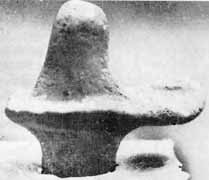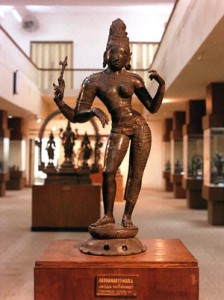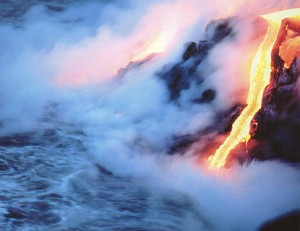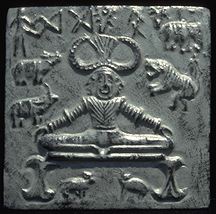We have been told for centuries that the Shivalinga represents Lord Shiva’s genitals. It represents the aspect of the Supreme Being that continuously dissolves to recreate the cyclic process of creation, preservation, dissolution of the universe. Lord Shiva is the foremost of the Sanatan Trinity to represent the last of the above aspect of cyclic process, the other two being Lord Brahma and Lord Vishnu.

A Classical Shivalinga
The Linga consists of a feminine base “Yoni” or “vagina” and a rising masculine portion “the Phallus” or “penis”. There are some twelve Jyotir-Linga scattered all over Bharat where, it is said, Lord Shiva appeared in the form of light or fire (Jyoti) Linga. They are Kedarnath in Uttarachal, Viswanath at Kashi, Somanath in Gujarat, Mahakaleswar at Ujjain, Tryambakeshvar near Nasik, Malikarjun at Srisailam in AP, Omkareshvar on river Narmada, Nageshvar at Darukvan in Maharashtra, Bhimeshwar at northwest of Poona, Rameshvar at Setubandha in Tamilnadu, Grineshvar near Elora caves and Vaijanath at Deogarh in Bihar. These narrations clearly indicate volcanic activities at these locations and subsequent creation of a mountain.
The love and devotion for Lord Shiva is so all pervading that apart from the Gods and humans even the demons worshiped Him with total devotion. The famous Demon king Ravana of Sri Lanka was known to be such a great devotee of Lord Shiva that Lord Rama allowed him to perform the Shiva worship (pooja) before slaying him. He blesses anyone who worships Him – be it a saint or a sinner.

A Terracotta Linga from Kalibangan (2600 BC)
The normal configuration in the temples has water pot (Kalash) dripping water on to flowers and leaves (Billipatra) adorned Linga. There is always a snake (Naga) encircling the Linga with basin (Yoni) channelling the water to a uniform flow outside the temple. Lord Shiva has always been accorded the highest place of reverence in the Sanatan culture. The complicated and ornate configuration may have begun during the later phase of the old Saraswati-sindhu era. A simple terracotta Linga has been found from Kalibangan (about 2600 BC) and it is shown here.
1The great Epics and Puranas have several different version of creational legend of Lord Shiva. In one version how a great fire appeared from the cosmic waters, and from its flame Shiva Linga emerged to claim supremacy and worship over Brahma and Vishnu. To control the tremendous energy thus generated, He castrated himself because no one could castrate the Supreme Lord. Thus the fallen phallus of the Supreme Lord destroyed all the worlds until it reached the Yoni of Uma/Parvati and cooled down. All procreation of worlds started after the worship of Yoni-Linga was established and all Gods, including Vishnu and Brahma accepted supremacy of Lord Shiva. This is clearly a description of volcanic activity and resultant cooling of lava by water as shown in the picture.

Lord Shiva
2Lord Shiva’s other form is “Ardhanariswara” half man and half woman. Lord Shiva, with his consort Parvati, is always in a celestial dance of procreation and destruction of the worlds. He is not only the embodiment of ‘Kama’ (the sexual lust, desire or pleasure, the force that is the basis for the evolution of diverse life forms and Humans on earth) in the forms of androgynous Ardhanarishwara and Phallus but also the destroyer of ‘Kama’ when he destroyed ‘Kamadeva’ only to restore his life at the request of Kama’s wife Rati. This description represents regeneration after havoc created by volcanoes and earthquakes due to plate tectonics. The resultant mountains (male) and the rivers (female) are clearly represented in dualistic form in “Ardhanariswara”.
3There is also a Legend of Parad (Mercury) Shiva Linga. According to this legend, the Gods, who frequently took a beating at the hands of the Rakshasas (demons), went to Lord Brahma for a lasting solution. Lord Brahma told them that only a warrior born out of Shaktipunj (semen of Lord Shiva) can lead the Gods to victory. The Gods prayed Lord Shiva who agreed and approached Goddess Parvati to conceive a son. The Gods sent Agni, the God of fire, in the form of a pigeon to observe the great event. Lord Shiva found this out and released His semen in the fire of Agni. Even the God of fire couldn’t bear the heat of Lord Shiva’s reproductive force and dropped it in the holy waters of river Ganges. Mother Ganges also couldn’t stand the heat and released it on Earth. After being sanctified by the holy fire and sacred waters of Ganges it became Mercury or Para – the only metal in liquid form. However, the solid form of mercury is popularly known as Parad.

Lava flows into the sea where it cools and forms into a rock
Solidifying mercury is an ancient Vedic science. Dharnidhar Sanhita has given sixteen steps through which the liquid mercury has to pass to make it pure and beneficially pliable solid. Then mercury can be moulded into solid Linga form. A number of references point to the holistic benefits of Parad Shivalinga. It is said that there is no better Shivalinga ever made than the one made out of mercury. In Sarvadarshana Sangraha, Lord Shiva says to Goddess Parvati that anyone who worships the Linga made out of solid mercury will face no death, disease or dearth.
This parable clearly indicates release of new materials (lava) after volcanic eruption and purification of these released materials. It clearly represents flow of lava like flow of mercury – the only metal which exists in liquid form and flows like fresh lava at ambient temperature conditions.
4Skanda Purana tells us that Lord Shiva used to love a great forest called the Sleshmantaka. It was here that Shiva spent so much time being immersed in the wilderness of this forest in merry-making assuming Himself the form of a deer. It is stated in the Skanda Purana – “As I reside here in the forest of Sleshmanta in the form of a beast, my name will hence be known as the Pashupati the world over”. To this day the Sleshmantaka forest remains sacred and is known as Mrigasthali (the abode of deer). The name Pashupati means “Lord of Animals” (Pashu -animal, Pati- Lord) and was later taken to mean (Lord of Souls). This legend is depicted on several tablets found at ruined cities (like Lothal, Dholavira, etc) of the Saraswatisindhi culture. One of these 4600 years old tablets appropriately called “Pashupati Seal” is shown here.

Pashupati Seal, Saraswati-Sindhu Pradesh (2800 BC)
All the above legends are conceptualized in the Puranas, Epics and Tantric books and should be considered secondary to the Vedas. There are no magical stories in the Vedas even though Rudra is mentioned in it. However, it is interesting to note that most of these stories clearly related to destruction by earthquake and/or by volcanoes and subsequent regeneration of the mountains, land, rivers which in turn allow return of destructed life to replenish the area again.

